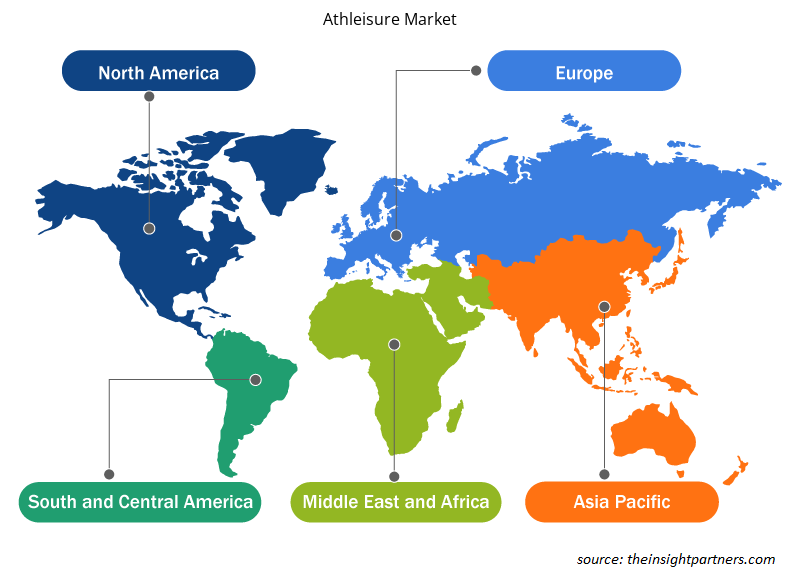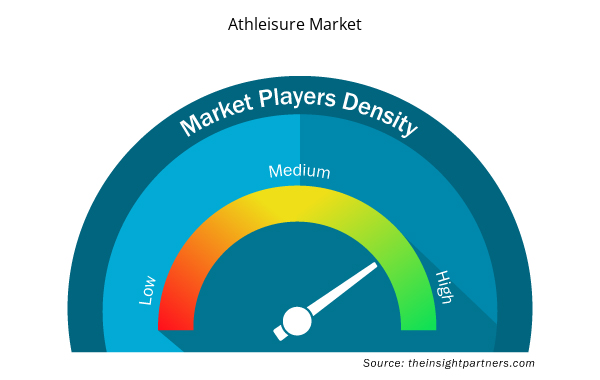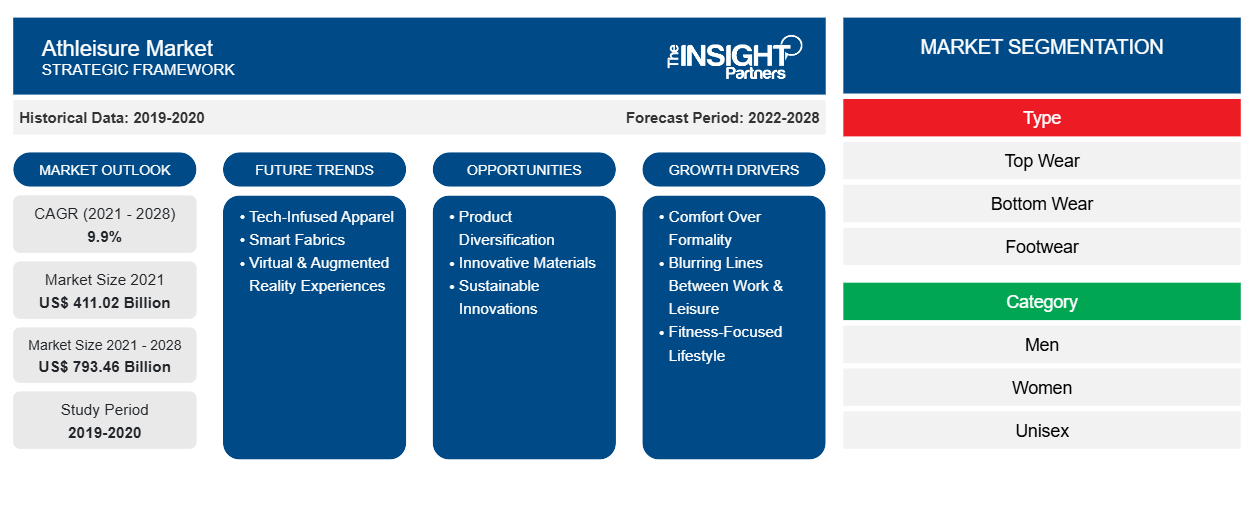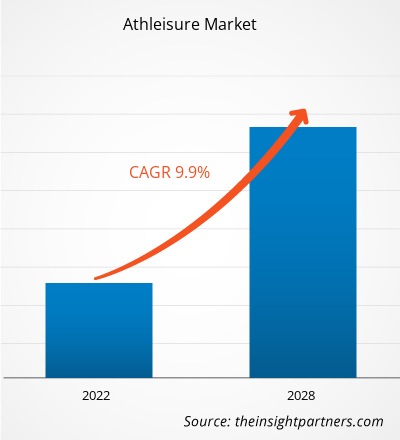Der Athleisure-Markt soll von 411,02 Milliarden US-Dollar im Jahr 2021 auf 793,46 Milliarden US-Dollar im Jahr 2028 wachsen; von 2021 bis 2028 wird mit einer durchschnittlichen jährlichen Wachstumsrate von 9,9 % gerechnet.
Athleisure bezeichnet einen Modetrend, der sich durch bequeme und ästhetisch ansprechende Sportbekleidung auszeichnet. Sie wird aus Materialien hergestellt, die traditionell für Sportbekleidung und Fitnesskleidung verwendet werden, ist aber so geschnitten, dass sie auch für die Freizeit geeignet ist.
Im Jahr 2020 dominierte Nordamerika den globalen Markt und wird seine Dominanz im Prognosezeitraum voraussichtlich beibehalten. Das steigende Bewusstsein für einen gesunden Lebensstil hat die Kunden in Nordamerika dazu ermutigt, Fitness-/Sportaktivitäten nachzugehen, was die Nachfrage nach Athleisure in der Region antreibt. Darüber hinaus stärken die zunehmende Präsenz internationaler und inländischer Marken und das steigende verfügbare Einkommen der Menschen, gepaart mit dem Wunsch nach einem verbesserten Lebensstil, die Nachfrage nach Athleisure in der Region. Die Akzeptanz von Athleisure in verschiedenen sozialen Umgebungen hat in den letzten Jahren deutlich zugenommen. Die modische Suche nach Yoga-Kleidung nahm 2020 in den USA zu und die Kunden entscheiden sich für mehr Farben bei ihren Yoga-Produkten. Darüber hinaus hielt der asiatisch-pazifische Raum den zweitgrößten Anteil am globalen Markt, was auf die wachsende Beliebtheit trendiger Sportausrüstung, einschließlich sportlicher Sportbekleidung und Schuhe, bei den Millennials in der Region zurückzuführen ist.
Passen Sie diesen Bericht Ihren Anforderungen an
Sie erhalten kostenlos individuelle Anpassungen an jedem Bericht, einschließlich Teilen dieses Berichts oder einer Analyse auf Länderebene, eines Excel-Datenpakets sowie tolle Angebote und Rabatte für Start-ups und Universitäten.
- Holen Sie sich die wichtigsten Markttrends aus diesem Bericht.Dieses KOSTENLOSE Beispiel umfasst eine Datenanalyse von Markttrends bis hin zu Schätzungen und Prognosen.
Markteinblicke
Steigendes Verbraucherbewusstsein hinsichtlich Gesundheit und Fitness fördert Marktwachstum
In den letzten Jahren ist das Bewusstsein für Gesundheit und Fitness bei Verbrauchern weltweit gestiegen. Laut einer Umfrage von McKinsey and Company, an der sechs Länder – Brasilien, China, Deutschland, Großbritannien, USA und Japan – teilnahmen, gaben 79 % der Befragten an, dass Wellness wichtig sei, und 42 % betrachteten Wellness als oberste Priorität. Dies deutet darauf hin, dass Verbraucher in verschiedenen Ländern ihrer Gesundheit und Fitness Priorität einräumen, was zu einer erhöhten Teilnahme an Yoga, Fitnessstudios und Sportaktivitäten geführt hat. Die Nachfrage nach geeigneter und trendiger Kleidung und Schuhen unter diesen gesundheitsbewussten Verbrauchern steigt und treibt damit das Marktwachstum voran.
Typ-Einblicke
Der Markt ist nach Typ in Oberbekleidung, Unterbekleidung, Schuhe und Sonstiges unterteilt. Das Schuhsegment wird voraussichtlich das am schnellsten wachsende Segment im Athleisure-Markt sein . Schuhe sind zu einem integralen Bestandteil der Sport- und Fitnessaktivitäten der Menschen geworden. Verbraucher verlangen zunehmend nach Schuhen mit unterschiedlichem Stil und Design, die für Fitnessstudios und Fitnessaktivitäten sowie für Outdoor-Events verwendet werden können.
Adidas AG; Asics; Athleta LLC; Authentic Brands Group; Columbia Sportswear Company; Hennes and Mauritz AB; Lululemon Athletica; Nike, Inc.; Puma SE; und Under Armour Inc. gehören zu den wichtigsten Akteuren auf dem Markt. Die führenden Akteure verfolgen verschiedene Strategien, wie Fusionen und Übernahmen sowie Produkteinführungen, um ihre geografische Präsenz und Kundenbasis zu erweitern.
Regionale Einblicke in den Athleisure-Markt
Die regionalen Trends und Faktoren, die den Athleisure-Markt im Prognosezeitraum beeinflussen, wurden von den Analysten von Insight Partners ausführlich erläutert. In diesem Abschnitt werden auch die Athleisure-Marktsegmente und die Geografie in Nordamerika, Europa, im asiatisch-pazifischen Raum, im Nahen Osten und Afrika sowie in Süd- und Mittelamerika erörtert.

- Holen Sie sich die regionalspezifischen Daten für den Athleisure-Markt
Umfang des Athleisure-Marktberichts
| Berichtsattribut | Details |
|---|---|
| Marktgröße im Jahr 2021 | 411,02 Milliarden US-Dollar |
| Marktgröße bis 2028 | 793,46 Milliarden US-Dollar |
| Globale CAGR (2021 - 2028) | 9,9 % |
| Historische Daten | 2019-2020 |
| Prognosezeitraum | 2022–2028 |
| Abgedeckte Segmente | Nach Typ
|
| Abgedeckte Regionen und Länder | Nordamerika
|
| Marktführer und wichtige Unternehmensprofile |
|
Dichte der Akteure auf dem Athleisure-Markt: Die Auswirkungen auf die Geschäftsdynamik verstehen
Der Athleisure-Markt wächst rasant, angetrieben von der steigenden Endverbrauchernachfrage aufgrund von Faktoren wie sich entwickelnden Verbraucherpräferenzen, technologischen Fortschritten und einem größeren Bewusstsein für die Vorteile des Produkts. Mit steigender Nachfrage erweitern Unternehmen ihr Angebot, entwickeln Innovationen, um die Bedürfnisse der Verbraucher zu erfüllen, und nutzen neue Trends, was das Marktwachstum weiter ankurbelt.
Die Marktteilnehmerdichte bezieht sich auf die Verteilung der Firmen oder Unternehmen, die in einem bestimmten Markt oder einer bestimmten Branche tätig sind. Sie gibt an, wie viele Wettbewerber (Marktteilnehmer) in einem bestimmten Marktraum im Verhältnis zu seiner Größe oder seinem gesamten Marktwert präsent sind.
Die wichtigsten auf dem Athleisure-Markt tätigen Unternehmen sind:
- Adidas AG
- Columbia Sportswear Unternehmen
- Gap Inc.
- Hennes & Mauritz AB
- ASICS Corporation
Haftungsausschluss : Die oben aufgeführten Unternehmen sind nicht in einer bestimmten Reihenfolge aufgeführt.

- Überblick über die wichtigsten Akteure auf dem Athleisure-Markt
Bericht-Spotlights
- Progressive Trends in der Athleisure-Branche helfen den Akteuren bei der Entwicklung wirksamer langfristiger Strategien
- Von Unternehmen verfolgte Geschäftswachstumsstrategien zur Sicherung des Wachstums in entwickelten und sich entwickelnden Märkten
- Quantitative Analyse des Athleisure-Marktes von 2019 bis 2028
- PEST-Analyse zur Veranschaulichung der Wirksamkeit von Einkäufern und Lieferanten in der Athleisure-Branche
- Aktuelle Entwicklungen zum Verständnis des Wettbewerbsmarktszenarios und der Nachfrage nach Athleisure
- Markttrends und -aussichten gepaart mit Faktoren, die das Wachstum des Athleisure-Marktes bestimmen
- Verständnis für die Strategien, die das kommerzielle Interesse am Wachstum des Athleisure-Marktes untermauern und den Entscheidungsprozess unterstützen
- Größe des Athleisure-Marktes an verschiedenen Marktknotenpunkten
- Detaillierter Überblick und Segmentierung des Athleisure-Marktes sowie seiner Branchendynamik
- Größe des Athleisure-Marktes in verschiedenen Regionen mit vielversprechenden Wachstumschancen
Die „Globale Athleisure-Marktanalyse bis 2028“ ist eine spezialisierte und eingehende Studie der Konsumgüterindustrie, die sich auf die Trendanalyse des Athleisure-Marktes konzentriert. Der Bericht soll einen Überblick über den Markt mit detaillierter Marktsegmentierung bieten. Der Athleisure-Markt ist nach Typ, Kategorie, Vertriebskanal und Geografie segmentiert. Nach Typ ist der Markt in Oberbekleidung, Unterbekleidung, Schuhe und Sonstiges segmentiert. Nach Kategorie ist der Athleisure-Markt in Männer, Frauen, Unisex und Kinder segmentiert. Nach Vertriebskanal ist der Markt in Supermärkte und Hypermärkte, Fachgeschäfte, Online-Einzelhandel und Sonstiges segmentiert. Nach Geografie ist der Markt in fünf Hauptregionen segmentiert: Nordamerika, Europa, Asien-Pazifik (APAC), Süd- und Mittelamerika (SCAM) sowie Naher Osten und Afrika (MEA). Asien-Pazifik wird voraussichtlich das am schnellsten wachsende Segment im Athleisure-Markt sein, gefolgt von Nordamerika.
Firmenprofile
- Adidas AG
- Asics
- Athleta LLC
- Authentische Markengruppe
- Columbia Sportswear Unternehmen
- Hennes und Mauritz AB
- Lululemon Athletica
- Nike, Inc.
- Puma SE
- Under Armour Inc.
- Historische Analyse (2 Jahre), Basisjahr, Prognose (7 Jahre) mit CAGR
- PEST- und SWOT-Analyse
- Marktgröße Wert/Volumen – Global, Regional, Land
- Branche und Wettbewerbsumfeld
- Excel-Datensatz



Report Coverage
Revenue forecast, Company Analysis, Industry landscape, Growth factors, and Trends

Segment Covered
This text is related
to segments covered.

Regional Scope
North America, Europe, Asia Pacific, Middle East & Africa, South & Central America

Country Scope
This text is related
to country scope.
Häufig gestellte Fragen
Rising health and self-consciousness, as well as a desire to live an active lifestyle and look fit, are motivating consumers to include sports and fitness activities into their daily routine. This increasing engagement has resulted in a shift in market dynamics, which has resulted in a rise in demand for athleisure products. As exercise becomes increasingly important, those between the ages of 16 and 30 are the most active athleisure users. These factors are driving the athleisure market.
During the forecast period, the footwear segment is expected to be the fastest-growing segment. Footwear demand has been boosted by an increase in the number of specialized and franchised footwear stores, as well as collaborations between footwear companies and other retail chains. Footwear segment will be influenced by product development advancements made by market participants.
Based on category, women is the fastest-growing segment. Women's increased engagement in sports and fitness is expected to fuel the market development. A growing number of women joining sports clubs is also predicted to fuel the market growth. Celebrity endorsements, marketing, and activities organized by well-known individuals have a significant influence on customers.
In 2020, the bottomwear segment accounted for the largest market share. Bottomwear products demand is being driven by rising internet penetration, changing lifestyles, and fashion trends. The growing popularity of bottomwear products in emerging markets provides a tremendous opportunity for manufacturers to focus on dynamic design and appearance.
The major players operating in the athleisure market are Adidas AG, Columbia Sportswear Company, Gap Inc., Hennes & Mauritz AB, ASICS Corporation, Lululemon Athletica Inc., Nike, Inc., Puma SE, Under Armour, Inc., and Authentic Brands Group LLC.
In 2020, North America accounted for the largest share of the global athleisure market. The athleisure industry is anticipated to expand faster due to increasing awareness of health and fitness. The growing number of gymnasiums, fitness clubs, and yoga centers, as well as the growth of the retail stores that sell customized hoodies, joggers, shoes, and etc., contributes to the market growth in the region.
Trends and growth analysis reports related to Consumer Goods : READ MORE..
The List of Companies - Athleisure Market
- Adidas AG
- Columbia Sportswear Company
- Gap Inc.
- Hennes & Mauritz AB
- ASICS Corporation
- Lululemon Athletica Inc.
- Nike, Inc.
- Puma SE
- Under Armour, Inc.
- Authentic Brands Group LLC
The Insight Partners performs research in 4 major stages: Data Collection & Secondary Research, Primary Research, Data Analysis and Data Triangulation & Final Review.
- Data Collection and Secondary Research:
As a market research and consulting firm operating from a decade, we have published and advised several client across the globe. First step for any study will start with an assessment of currently available data and insights from existing reports. Further, historical and current market information is collected from Investor Presentations, Annual Reports, SEC Filings, etc., and other information related to company’s performance and market positioning are gathered from Paid Databases (Factiva, Hoovers, and Reuters) and various other publications available in public domain.
Several associations trade associates, technical forums, institutes, societies and organization are accessed to gain technical as well as market related insights through their publications such as research papers, blogs and press releases related to the studies are referred to get cues about the market. Further, white papers, journals, magazines, and other news articles published in last 3 years are scrutinized and analyzed to understand the current market trends.
- Primary Research:
The primarily interview analysis comprise of data obtained from industry participants interview and answers to survey questions gathered by in-house primary team.
For primary research, interviews are conducted with industry experts/CEOs/Marketing Managers/VPs/Subject Matter Experts from both demand and supply side to get a 360-degree view of the market. The primary team conducts several interviews based on the complexity of the markets to understand the various market trends and dynamics which makes research more credible and precise.
A typical research interview fulfils the following functions:
- Provides first-hand information on the market size, market trends, growth trends, competitive landscape, and outlook
- Validates and strengthens in-house secondary research findings
- Develops the analysis team’s expertise and market understanding
Primary research involves email interactions and telephone interviews for each market, category, segment, and sub-segment across geographies. The participants who typically take part in such a process include, but are not limited to:
- Industry participants: VPs, business development managers, market intelligence managers and national sales managers
- Outside experts: Valuation experts, research analysts and key opinion leaders specializing in the electronics and semiconductor industry.
Below is the breakup of our primary respondents by company, designation, and region:

Once we receive the confirmation from primary research sources or primary respondents, we finalize the base year market estimation and forecast the data as per the macroeconomic and microeconomic factors assessed during data collection.
- Data Analysis:
Once data is validated through both secondary as well as primary respondents, we finalize the market estimations by hypothesis formulation and factor analysis at regional and country level.
- Macro-Economic Factor Analysis:
We analyse macroeconomic indicators such the gross domestic product (GDP), increase in the demand for goods and services across industries, technological advancement, regional economic growth, governmental policies, the influence of COVID-19, PEST analysis, and other aspects. This analysis aids in setting benchmarks for various nations/regions and approximating market splits. Additionally, the general trend of the aforementioned components aid in determining the market's development possibilities.
- Country Level Data:
Various factors that are especially aligned to the country are taken into account to determine the market size for a certain area and country, including the presence of vendors, such as headquarters and offices, the country's GDP, demand patterns, and industry growth. To comprehend the market dynamics for the nation, a number of growth variables, inhibitors, application areas, and current market trends are researched. The aforementioned elements aid in determining the country's overall market's growth potential.
- Company Profile:
The “Table of Contents” is formulated by listing and analyzing more than 25 - 30 companies operating in the market ecosystem across geographies. However, we profile only 10 companies as a standard practice in our syndicate reports. These 10 companies comprise leading, emerging, and regional players. Nonetheless, our analysis is not restricted to the 10 listed companies, we also analyze other companies present in the market to develop a holistic view and understand the prevailing trends. The “Company Profiles” section in the report covers key facts, business description, products & services, financial information, SWOT analysis, and key developments. The financial information presented is extracted from the annual reports and official documents of the publicly listed companies. Upon collecting the information for the sections of respective companies, we verify them via various primary sources and then compile the data in respective company profiles. The company level information helps us in deriving the base number as well as in forecasting the market size.
- Developing Base Number:
Aggregation of sales statistics (2020-2022) and macro-economic factor, and other secondary and primary research insights are utilized to arrive at base number and related market shares for 2022. The data gaps are identified in this step and relevant market data is analyzed, collected from paid primary interviews or databases. On finalizing the base year market size, forecasts are developed on the basis of macro-economic, industry and market growth factors and company level analysis.
- Data Triangulation and Final Review:
The market findings and base year market size calculations are validated from supply as well as demand side. Demand side validations are based on macro-economic factor analysis and benchmarks for respective regions and countries. In case of supply side validations, revenues of major companies are estimated (in case not available) based on industry benchmark, approximate number of employees, product portfolio, and primary interviews revenues are gathered. Further revenue from target product/service segment is assessed to avoid overshooting of market statistics. In case of heavy deviations between supply and demand side values, all thes steps are repeated to achieve synchronization.
We follow an iterative model, wherein we share our research findings with Subject Matter Experts (SME’s) and Key Opinion Leaders (KOLs) until consensus view of the market is not formulated – this model negates any drastic deviation in the opinions of experts. Only validated and universally acceptable research findings are quoted in our reports.
We have important check points that we use to validate our research findings – which we call – data triangulation, where we validate the information, we generate from secondary sources with primary interviews and then we re-validate with our internal data bases and Subject matter experts. This comprehensive model enables us to deliver high quality, reliable data in shortest possible time.


 Holen Sie sich ein kostenloses Muster für diesen Bericht
Holen Sie sich ein kostenloses Muster für diesen Bericht